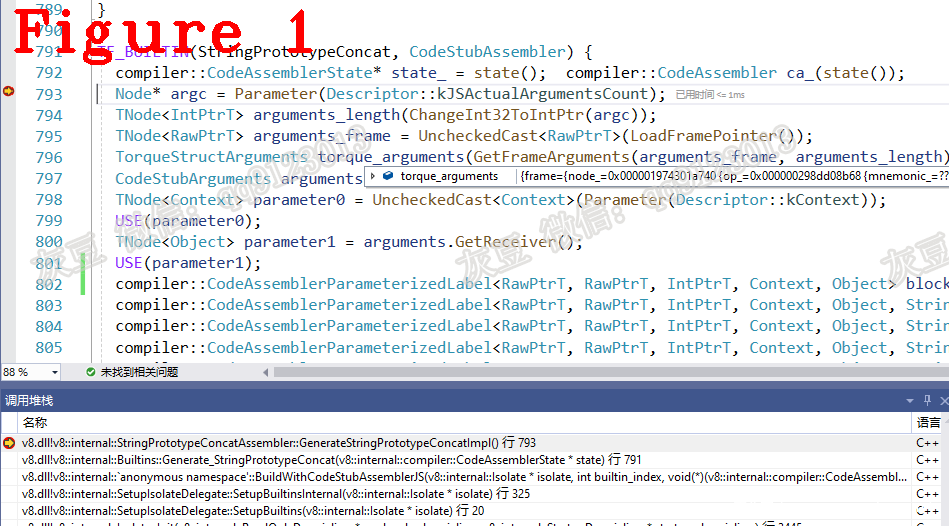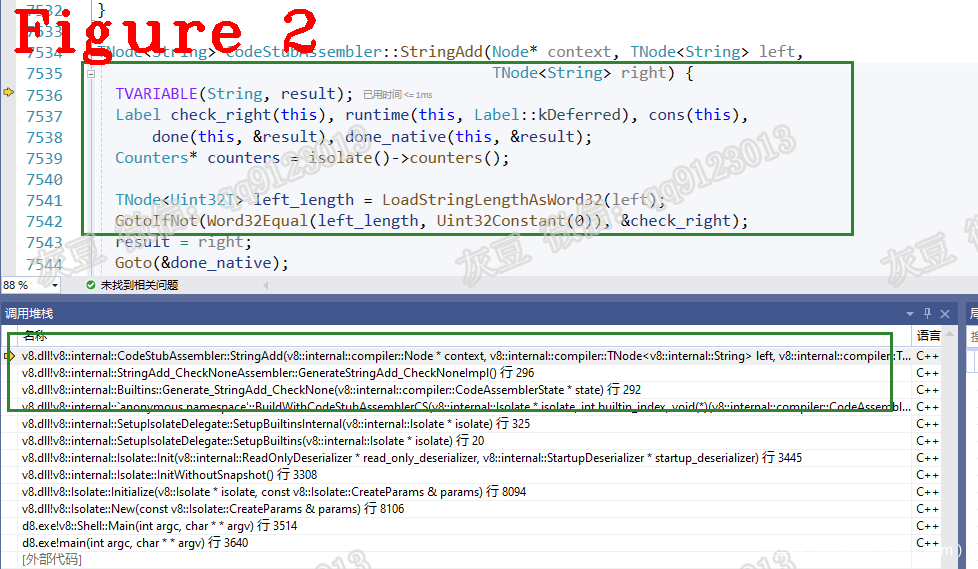《Chrome V8 源码》36. String.prototype.concat 源码分析
《Chrome V8 源码》36. String.prototype.concat 源码分析

1 介绍
字符串是 JavaScript 中的重要数据类型,其重要性不仅体现在字符串是应用最多最广泛的数据类型,更体现在V8中使用了大量的技术手段来修饰和优化字符串的操作。接下来的几篇文章将集中讲解字符串的相关操作。本文先讲解 String.prototype.concat 的源码以及相关数据结构,再通过测试用例演示 String.prototype.concat 的调用、加载和执行过程。
注意 (1)Sea of Nodes 是本文的先导知识,请参考 Cliff 1993年发表的论文 From Quads to Graphs。(2)本文所用环境为:V8 7.9、win10 x64、VS2019。
2 String.prototype.concat 源码
测试用例代码如下:
var txt1 = "he ", txt2="is ", txt3="HuiDou ", txt4=".";
var bio = txt1.concat(txt2,txt3,txt4);
console.log(bio);
concet() 是用 TF_BUILTIN 实现的,concet() 在 V8 中的函数名是 StringPrototypeConcat,编号是 888,源码如下:
1. TF_BUILTIN(StringPrototypeConcat, CodeStubAssembler) {
2. ca_.Goto(&block0, torque_arguments.frame, torque_arguments.base, torque_arguments.length, parameter0, parameter1);
3. if (block0.is_used()) {//省略..............
4. ca_.Bind(&block0, &tmp0, &tmp1, &tmp2, &tmp3, &tmp4);
5. ca_.SetSourcePosition("../../../src/builtins/string.tq", 128);
6. compiler::TNode<String> tmp5;
7. USE(tmp5);
8. tmp5 = FromConstexpr6String18ATconstexpr_string_156(state_, "String.prototype.concat");
9. compiler::TNode<String> tmp6;
10. USE(tmp6);
11. tmp6 = CodeStubAssembler(state_).ToThisString(compiler::TNode<Context>{tmp3}, compiler::TNode<Object>{tmp4}, compiler::TNode<String>{tmp5});
12. ca_.SetSourcePosition("../../../src/builtins/string.tq", 131);
13. compiler::TNode<IntPtrT> tmp7;
14. USE(tmp7);
15. tmp7 = Convert8ATintptr8ATintptr_1494(state_, compiler::TNode<IntPtrT>{tmp2});
16. ca_.SetSourcePosition("../../../src/builtins/string.tq", 132);
17. compiler::TNode<IntPtrT> tmp8;
18. USE(tmp8);
19. tmp8 = FromConstexpr8ATintptr17ATconstexpr_int31_150(state_, 0);
20. ca_.Goto(&block3, tmp0, tmp1, tmp2, tmp3, tmp4, tmp6, tmp7, tmp8);
21. }
22. if (block3.is_used()) {//省略..............
23. ca_.Bind(&block3, &tmp9, &tmp10, &tmp11, &tmp12, &tmp13, &tmp14, &tmp15, &tmp16);
24. compiler::TNode<BoolT> tmp17;
25. USE(tmp17);
26. tmp17 = CodeStubAssembler(state_).IntPtrLessThan(compiler::TNode<IntPtrT>{tmp16}, compiler::TNode<IntPtrT>{tmp15});
27. ca_.Branch(tmp17, &block1, &block2, tmp9, tmp10, tmp11, tmp12, tmp13, tmp14, tmp15, tmp16);
28. }
29. if (block1.is_used()) {//省略..............
30. ca_.Bind(&block1, &tmp18, &tmp19, &tmp20, &tmp21, &tmp22, &tmp23, &tmp24, &tmp25);
31. ca_.SetSourcePosition("../../../src/builtins/string.tq", 133);
32. compiler::TNode<Object> tmp26;
33. USE(tmp26);
34. tmp26 = CodeStubAssembler(state_).GetArgumentValue(TorqueStructArguments{compiler::TNode<RawPtrT>{tmp18}, compiler::TNode<RawPtrT>{tmp19}, compiler::TNode<IntPtrT>{tmp20}}, compiler::TNode<IntPtrT>{tmp25});
35. compiler::TNode<String> tmp27;
36. USE(tmp27);
37. tmp27 = CodeStubAssembler(state_).ToString_Inline(compiler::TNode<Context>{tmp21}, compiler::TNode<Object>{tmp26});
38. ca_.SetSourcePosition("../../../src/builtins/string.tq", 134);
39. compiler::TNode<String> tmp28;
40. USE(tmp28);
41. tmp28 = StringAdd_82(state_, compiler::TNode<Context>{tmp21}, compiler::TNode<String>{tmp23}, compiler::TNode<String>{tmp27});
42. ca_.SetSourcePosition("../../../src/builtins/string.tq", 132);
43. ca_.Goto(&block4, tmp18, tmp19, tmp20, tmp21, tmp22, tmp28, tmp24, tmp25);
44. }
45. if (block4.is_used()) {//省略..............
46. ca_.Bind(&block4, &tmp29, &tmp30, &tmp31, &tmp32, &tmp33, &tmp34, &tmp35, &tmp36);
47. compiler::TNode<IntPtrT> tmp37;
48. USE(tmp37);
49. tmp37 = FromConstexpr8ATintptr17ATconstexpr_int31_150(state_, 1);
50. compiler::TNode<IntPtrT> tmp38;
51. USE(tmp38);
52. tmp38 = CodeStubAssembler(state_).IntPtrAdd(compiler::TNode<IntPtrT>{tmp36}, compiler::TNode<IntPtrT>{tmp37});
53. ca_.Goto(&block3, tmp29, tmp30, tmp31, tmp32, tmp33, tmp34, tmp35, tmp38);
54. }
55. if (block2.is_used()) {//省略..............
56. ca_.Bind(&block2, &tmp39, &tmp40, &tmp41, &tmp42, &tmp43, &tmp44, &tmp45, &tmp46);
57. ca_.SetSourcePosition("../../../src/builtins/string.tq", 136);
58. arguments.PopAndReturn(tmp44);
59. }
60. }
上述代码中定义了四个 block(block0-block4),它们的作用是:
block0 创建三个变量:初始字符串 tmp6(即测试用例中的“he”)、拼接总数 tmp7(测试用例中的数量为 3)和完成拼接的数量 tmp8(初始值为 0);
block1 把两个字符串拼接在一起生成一个新字符串;
block2 返回最终结果;
block3 判断完成拼接的数量是否小于拼接总数,如果小于跳转到 block1,如果不小于跳转到 blcok2;
block4 把完成拼接的数量加 1。
从这些 block 在代码中的分布位置可以看出,他们使用 while 循环方式实现了字符串的拼接。图 1 给出了 StringPrototypeConcat 源码的位置。

下面说明 StringPrototypeConcat 用到的重要函数:
(1) ToThisString(第 11 行代码)的作用是把对象转换成字符串,源码如下:
1. TNode<String> CodeStubAssembler::ToThisString(/*省略*/) {
2. BIND(&if_valueisnotsmi);//省略....
3. { TNode<Uint16T> value_instance_type = LoadInstanceType(CAST(value));
4. Label if_valueisnotstring(this, Label::kDeferred);
5. Branch(IsStringInstanceType(value_instance_type), &if_valueisstring,
6. &if_valueisnotstring);
7. BIND(&if_valueisnotstring);
8. { Label if_valueisnullorundefined(this, Label::kDeferred);
9. GotoIf(IsNullOrUndefined(value), &if_valueisnullorundefined);
10. var_value.Bind(CallBuiltin(Builtins::kToString, context, value));
11. Goto(&if_valueisstring);
12. BIND(&if_valueisnullorundefined);
13. {ThrowTypeError(context, MessageTemplate::kCalledOnNullOrUndefined,
14. method_name);}
15. }
16. }
17. BIND(&if_valueissmi);
18. {var_value.Bind(CallBuiltin(Builtins::kNumberToString, context, value));
19. Goto(&if_valueisstring); }
20. BIND(&if_valueisstring);
21. return CAST(var_value.value());
上述代码中第 2-16 行用于把非 small integer 数据转换成字符串,非 small integer 可以是数组、浮点数等。其中转换操作的具体功能由第 10 行的 kToString 实现;第 17-19 行用于把 small integer 数据转换成字符串,转换操作的具体功能由第 18 行的 kNumberToString 实现。后续文章会单独讲解 kToString 和 kNumberToString 方法。
(2) IntPtrAdd(第 52 行)实现整型数据的加法,源码如下:
1. TNode<WordT> CodeAssembler::IntPtrAdd(SloppyTNode<WordT> left,
2. SloppyTNode<WordT> right) {
3. intptr_t left_constant;
4. bool is_left_constant = ToIntPtrConstant(left, &left_constant);
5. intptr_t right_constant;
6. bool is_right_constant = ToIntPtrConstant(right, &right_constant);
7. if (is_left_constant) {
8. if (is_right_constant) {
9. return IntPtrConstant(left_constant + right_constant);}
10. if (left_constant == 0) { return right;}
11. } else if (is_right_constant) {
12. if (right_constant == 0) {return left;}
13. }
14. return UncheckedCast<WordT>(raw_assembler()->IntPtrAdd(left, right));}
上述代码中第 7-13 行用于常量的加法运算,其中第 7-8 行判断加法的左右值,如果都为常量则直接计算结果(第 9 行);第 10 行代码判断左值,如果为零则直接返回右值;第 14 行代码表示当左、右值均为变量时,则需要添加计算节点。
(3) StringAdd_82(第 41 行)中调用 Builtins::kStringAdd_CheckNone 方法,该方法使用 CodeStubAssembler::StringAdd 完成字符串的加法运算,StringAdd 的源码如下:
1. TNode<String> CodeStubAssembler::StringAdd(Node* context, TNode<String> left,
2. TNode<String> right) {
3. TNode<Uint32T> left_length = LoadStringLengthAsWord32(left);
4. GotoIfNot(Word32Equal(left_length, Uint32Constant(0)), &check_right);
5. result = right;
6. Goto(&done_native);
7. BIND(&check_right);
8. TNode<Uint32T> right_length = LoadStringLengthAsWord32(right);
9. GotoIfNot(Word32Equal(right_length, Uint32Constant(0)), &cons);
10. result = left;
11. Goto(&done_native);
12. BIND(&cons);
13. {
14. TNode<Uint32T> new_length = Uint32Add(left_length, right_length);
15. GotoIf(Uint32GreaterThan(new_length, Uint32Constant(String::kMaxLength)),
16. &runtime);
17. TVARIABLE(String, var_left, left);
18. TVARIABLE(String, var_right, right);
19. Variable* input_vars[2] = {&var_left, &var_right};
20. Label non_cons(this, 2, input_vars);
21. Label slow(this, Label::kDeferred);
22. GotoIf(Uint32LessThan(new_length, Uint32Constant(ConsString::kMinLength)),
23. &non_cons);
24. result =AllocateConsString(new_length, var_left.value(), var_right.value());
25. Goto(&done_native);
26. BIND(&non_cons);
27. TNode<Int32T> left_instance_type = LoadInstanceType(var_left.value());
28. TNode<Int32T> right_instance_type = LoadInstanceType(var_right.value());
29. TNode<Int32T> ored_instance_types =
30. Word32Or(left_instance_type, right_instance_type);
31. TNode<Word32T> xored_instance_types =
32. Word32Xor(left_instance_type, right_instance_type);
33. GotoIf(IsSetWord32(xored_instance_types, kStringEncodingMask), &runtime);
34. GotoIf(IsSetWord32(ored_instance_types, kStringRepresentationMask), &slow);
35. TNode<IntPtrT> word_left_length = Signed(ChangeUint32ToWord(left_length));
36. TNode<IntPtrT> word_right_length = Signed(ChangeUint32ToWord(right_length));
37. Label two_byte(this);
38. GotoIf(Word32Equal(Word32And(ored_instance_types,
39. Int32Constant(kStringEncodingMask)),
40. Int32Constant(kTwoByteStringTag)),&two_byte);
41. result = AllocateSeqOneByteString(new_length);
42. CopyStringCharacters(/*拷贝左字符串*/);
43. CopyStringCharacters(/*拷贝右字符串*/);
44. Goto(&done_native);
45. BIND(&two_byte);
46. {
47. result = AllocateSeqTwoByteString(new_length);
48. CopyStringCharacters(/*拷贝左字符串*/);
49. CopyStringCharacters(/*拷贝右字符串*/);
50. Goto(&done_native); }
51. BIND(&slow);
52. {
53. MaybeDerefIndirectStrings(&var_left, left_instance_type, &var_right,
54. right_instance_type, &non_cons);
55. Goto(&runtime);}}
56. BIND(&runtime);
57. {//省略.....
58. Goto(&done); }
59. BIND(&done_native);
60. { Goto(&done); }
61. BIND(&done);
62. return result.value();}
上述代码中,第 3-6 行代码判断左值长度是否为零,如果为零则直接返回右值;
第 7-11 行代码判断右值长度是否为零,如果为零则直接返回左值;
第 14-15 行代码判断新字符串的长度是否大于 V8 规定的字符串的最大长度,如果大于则使用 runtime 方式处理;
第 22 行代码判断新字符串的长度是否小于 V8 规定的字符串的最小长度,如果小于则使用 slow 或 runtime 方式处理;
第 27-34 行代码判断左、右值的编码是否一致且是否都为 sequential string,如是结果为真则执行第 35-50 行代码;
第 35-50 行代码根据单、双字节的不同,采用不同的方式创建并返回新的字符串,函数执行完毕;
第 51-58 行代码采用 slow 和 runtime 方式处理字符串。
图 2 给出了 StringAdd() 的调用堆栈。

3.String.prototype.concat 测试
测试用例的字节码如下:
1. //省略........
2. 11 S> 000001332DAC2C86 @ 16 : 12 01 LdaConstant [1]
3. 11 E> 000001332DAC2C88 @ 18 : 15 02 0a StaGlobal [2], [10]
4. //省略........
5. 64 S> 000001332DAC2C9A @ 36 : 13 02 00 LdaGlobal [2], [0]
6. 000001332DAC2C9D @ 39 : 26 f9 Star r2
7. 69 E> 000001332DAC2C9F @ 41 : 29 f9 09 LdaNamedPropertyNoFeedback r2, [9]
8. //省略........
9. 69 E> 000001332DAC2CB3 @ 61 : 5f fa f9 04 CallNoFeedback r1, r2-r5
10. //省略........
11. Constant pool (size = 13)
12. 000001332DAC2BC9: [FixedArray] in OldSpace
13. - map: 0x00df20ec0169 <Map>
14. - length: 13
15. 0: 0x01332dac2b09 <FixedArray[20]>
16. 1: 0x01332dac29d9 <String[#3]: he >
17. 2: 0x01332dac29c1 <String[#4]: txt1>
18. 3: 0x01332dac2a09 <String[#3]: is >
19. 4: 0x01332dac29f1 <String[#4]: txt2>
20. 5: 0x01332dac2a39 <String[#7]: HuiDou >
21. 6: 0x01332dac2a21 <String[#4]: txt3>
22. 7: 0x00df20ec4369 <String[#1]: .>
23. 8: 0x01332dac2a51 <String[#4]: txt4>
24. 9: 0x037ebea28b49 <String[#6]: concat>
25. 10: 0x01332dac2a69 <String[#3]: bio>
26. 11: 0x037ebea336f1 <String[#7]: console>
27. 12: 0x037ebea32d31 <String[#3]: log>
上述代码中,第 2-3 行加载并存储字符串 “he”;第 5-6 行把字符串 “he” 保存到 r2 寄存器中; 第 7 行加载 concat 方法;第 9 行调用 concat 方法,r1 寄存器的值是 concat 的地址,r2-r5 依次是 “he ”、“is ”、“HuiDou ” 和 “.”。debug测试方法:从 CallNoFeedback 开始进行汇编跟踪,如图 3 所示。

技术总结
(1) 拼接前要判断左、右字符串的类型、编码以及单双字节是否一致;
(2) 拼接采用循环方式对字符串两两拼接;
(3) 字符串的最大长度是 String::kMaxLength(1073741799)。
好了,今天到这里,下次见。
个人能力有限,有不足与纰漏,欢迎批评指正
微信:qq9123013 备注:v8交流 邮箱:v8blink@outlook.com
